
Sōhei: Japanese Warrior Monks
Sōhei (僧兵) were Japanese Buddhist warrior monks during Japan’s feudal years. There was a time in Japanese history when the Sōhei held enough power to influence the Japanese imperial and military governments to work together. They are similar to the yamabushi warrior monks, but the sōhei organized themselves onto armies or mobs, while the yamabushi worked alone. A famous sōhei monastery is the Enryaku-ji on Mount Hiei.
Japanese print depicting a story of the famous sōhei, Benkei.
Japanese warrior monks were also known as Buddha’s soldiers during the Heian (794-1185) through the Kamakura (1185-1333) periods. This was a time of political feuds among Buddhist temples and sects over who was to be appointed in the top positions of the temples around Kyoto, Ōmi, and Nara. The four largest temples were Tōdai-ji, Kōfuku-ji, Enryaku-ji, and Mii-dera. The first armed conflict happened in 949 when 56 monks from Tōdai-ji protested at the residence of a Kyoto official over an appointment that they did not approve of. This led to even larger feuds in the 12th century like the civil war known as the Genpei War. The warring clans of Minamoto and Taira fought to obtain aid from warrior monks of Nara and Kyoto to add to their own armies.
The naginata, a traditional Japanese sword, is the weapon most associated with the sōhei, although they used varied armaments. They are known to be proficient in using wakizashi (dagger and shortsword), bow and arrow, and tantō, a short sword. Many of them fought on horseback and used the samurai armor, Ō-yoroi. They also wore kimono-like robes that have changed very little over the years.

The sōhei contributed to the proliferation of Tendai Buddhism in Japan, because they were responsible for protecting the lands and they intimidated other rival schools.
Saito Musashibo Benkei (西塔武蔵坊弁慶, 1155-1189).Japanese warrior monk.This picture was drawn by Kikuchi-Yosai(菊池容斎)who was Japanese painter.
They are mentioned in many of the early Japanese texts and scrolls such as the “The Heike Story”. Musashibō Benkei (武蔵坊弁慶, 1155–1189), is one of the more popular Japanese warrior monks who served Minamoto no Yoshitsune, one of the greatest warriors of Japan. Benkei was responsible for teaching the young Minamoto how to wield the sword. Benkei was completely loyal to Minamoto, a perfect example of true devotion that has led to his presence in the annals of history.

